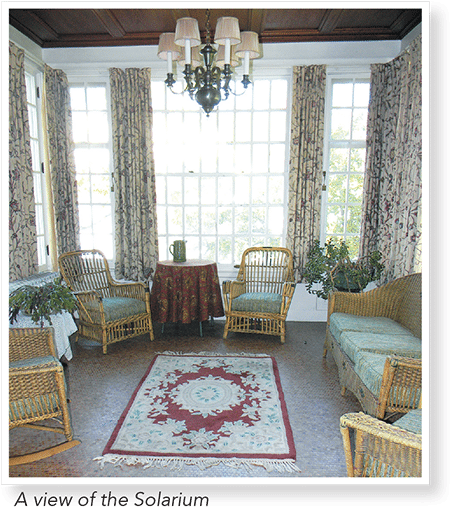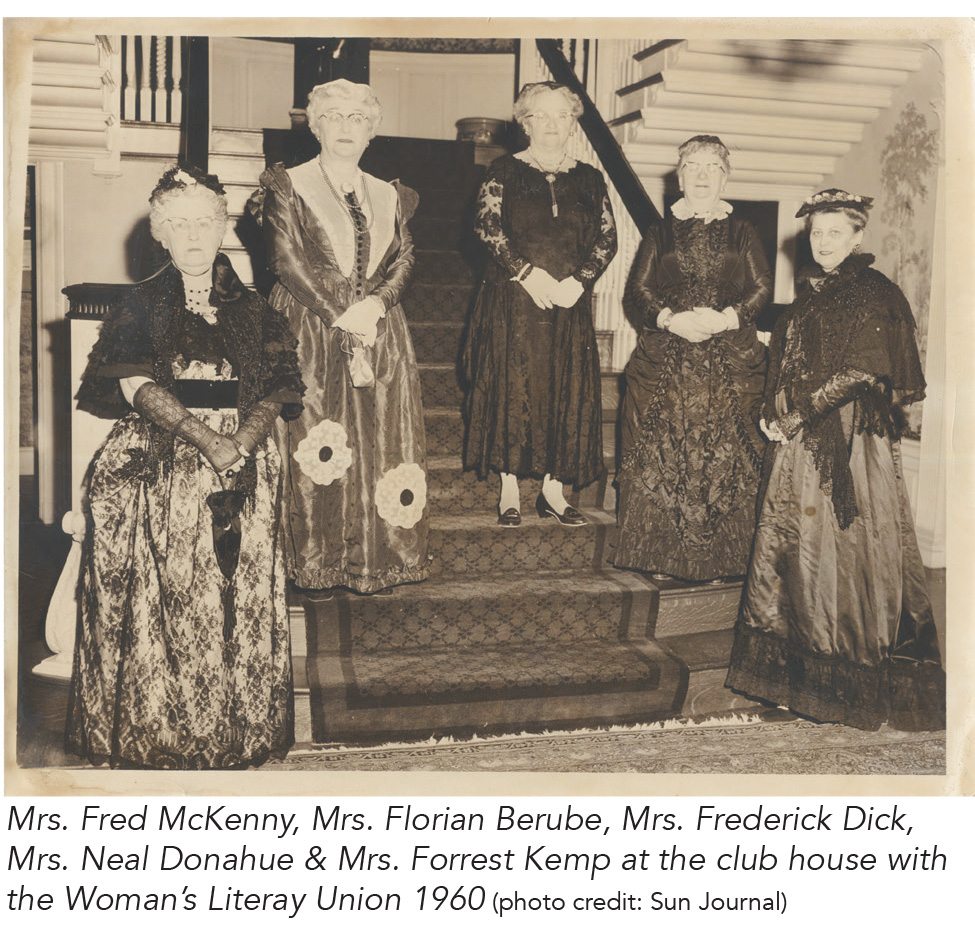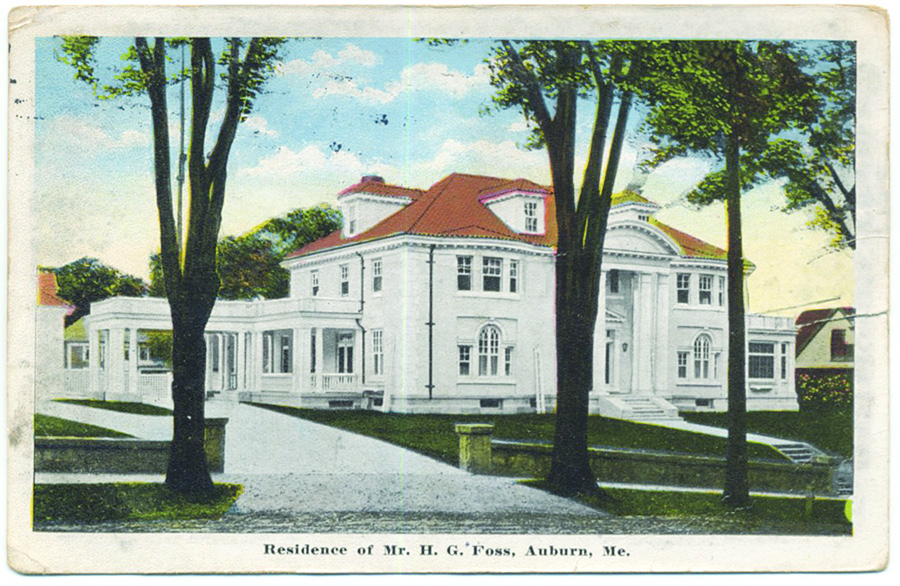The Horatio and Ella Foss Mansion
Enduring elegance in downtown Auburn
by Donna Keene Rousseau
Dotted throughout the neighborhoods of downtown Auburn are the historic homes of yesteryear. Their striking architectural bones define them as the “grande dames” of their age. Listed on the National Register of Places in 1976, the Horatio G. Foss Mansion of 19 Elm Street in Auburn, with its unique aesthetic balance of Georgian Revival and Spanish influence, serves as reminder of a bygone era of elegance and refinement in our city’s history.
The mansion was designed by two Lewiston architects, Eugene J. Gibbs and Addison Pulsifer, for Horatio G. Foss, owner of Dingley, Foss & Company, and his wife, Ella May Fletcher Foss, both Maine natives. Construction began in 1914 on the site of another landmark home, originally known as the Pickard Home and later the Pickard-Briggs Home; the property was sold by Samuel Pickard, son-in-law of Squire Edward Little. The tearing down and clearing of that property contributed to the three years it took to complete the Foss home in 1917. According to an article in the Lewiston Daily Sun, during the excavation on the lot, three sets of human skeletons were unearthed, later thought to be ancient Native American remains.
A regal face
Today, the mansion commands Elm Street from its elevated perch with its striking two-story porch supported by four Roman Doric (Greek) columns, Palladian entryways and windows. White stucco exterior covers terra cotta tile walls and provides distinct contrast to its red clay tile hip roof. The southern-facing main façade features three symmetrical bays, including a two-story tall pair of bays flanking the central entry, which is sheltered by a portico topped by a segmented-arch pediment. The cornices of the portico, doorway pediment, and roof, including the lines of the roof dormers, are all supported by ornate brackets, or modillions, architectural details contributing to the home’s regal imperative.
Making an entrance
The front entry door, constructed of solid wood and accented by leaded glass sidelights, is topped by a rectangular transom and leads to a tiled vestibule opening onto a central hall. If the mansion’s outside beauty emblazons its image in the mind’s eye, the interior of the three-story home does not disappoint, once over its threshold. Entering the high-ceilinged central hall lit by crystal chandeliers, the eye meets the grandeur of a flying oak staircase that conjures images of sweeping ballgowns descending the wide, red carpet-covered steps at a long-forgotten soiree. The newel posts of the staircase feature three designs and a mahogany bannister. Five bowed stained-glass windows, two of which are on interior walls, and a handsome grandfather clock, grace the circular landing where the staircase splits.

From the central hall and to the left is a living room of 22×26 feet, featuring an ample fireplace and French doors opening onto the tiled, palm corridor. A half bath is located to one end of the corridor; the porte cochere, a roofed structure extending from the house over the driveway to shelter guests entering or exiting their automobiles, appoints the other.
 To the right of the grand central hall is the library with a second fireplace. Beyond it is a tiled solarium which, in earlier descriptions, was “to be one of the most attractive apartments of the whole mansion”. The dining room, measuring 20×28 feet and boasting 560 square feet, is also accessed from the central hall as well as through a French window entrance in the solarium. It features a “concealed” lighting system – electrical lamps placed along walls and strategically hidden behind decorative mouldings –which directed the light to the ceiling and reflected illumination over the room. The system was thought to the best of any system of that time for creating the softest lighting and quality illumination. The oak paneled dining room’s fireplace mantel piece in this room is carved with floral garlands and flanked on either side with built-in china closets. Sliding pocket doors provide for privacy in dining.
To the right of the grand central hall is the library with a second fireplace. Beyond it is a tiled solarium which, in earlier descriptions, was “to be one of the most attractive apartments of the whole mansion”. The dining room, measuring 20×28 feet and boasting 560 square feet, is also accessed from the central hall as well as through a French window entrance in the solarium. It features a “concealed” lighting system – electrical lamps placed along walls and strategically hidden behind decorative mouldings –which directed the light to the ceiling and reflected illumination over the room. The system was thought to the best of any system of that time for creating the softest lighting and quality illumination. The oak paneled dining room’s fireplace mantel piece in this room is carved with floral garlands and flanked on either side with built-in china closets. Sliding pocket doors provide for privacy in dining.
Where beauty meets function
The kitchen, located in back of the dining room, is accessed through the butler’s pantry, which has a steel vegetable sink. The dumbwaiter ascends from the ice room to the second floor and maintains access to the dining room through two tabletop openings. A back staircase leads to the upper floors.
Each of the five spacious bedrooms on the second floor has it owns bathroom. One of the five rooms was reserved for the second floor servants. The back staircase leads to additional servants’ quarters, storage, and a large room finished with tongue-in-groove boards that served as a recreation or billiard room on the third story.
 The basement, not open to the public, is reached by a stairway in the back hallway. Divided into many rooms, this floor was for functionality and housed the furnace, coal storage, vegetable/root cellar and laundry room. During WWII, the Women’s Literary Union, to whom Mrs. Foss willed the mansion upon her death in 1941, granted the Red Cross to use a room in the basement for home nursing classes.
The basement, not open to the public, is reached by a stairway in the back hallway. Divided into many rooms, this floor was for functionality and housed the furnace, coal storage, vegetable/root cellar and laundry room. During WWII, the Women’s Literary Union, to whom Mrs. Foss willed the mansion upon her death in 1941, granted the Red Cross to use a room in the basement for home nursing classes.
In addition to the woodworking craftsmanship throughout the home, other remarkable features include a central vacuuming system, original paintings and décor, period wallpaper, Persian rugs, and flower gardens like those Mrs. Foss enjoyed during her life in the mansion. A detached two-car garage, designed with a turntable, is located off the porte cochere. Once driven onto the turntable, a car could be turned by manual crank to position it to face the street for ease in exiting the garage. The building also had a basement, as well as chauffeur quarters upstairs.
Ever the hostess
Mrs. Foss bequeathed her home to the Woman’s Literary Union, of which she was a member, upon her death in 1941. Seventy five years later, the organization remains a faithful steward and through its fundraising efforts maintains the home and makes necessary repairs and renovations. The WLU’s fundraisers include doll and tea parties, BUNCO gatherings, craft fairs, and holiday open houses, to name a few. The mansion is also available as a venue for bridal and baby showers and other celebrations.
A Maine native, Donna has dedicated much of her career to assisting families as they navigate the world of eldercare. Her philosophy is, “Create good by approaching all things with an open mind and a generous, honest heart;” it has served her well, personally and professionally.
--
Writing is her happy place and her family is her heart.


